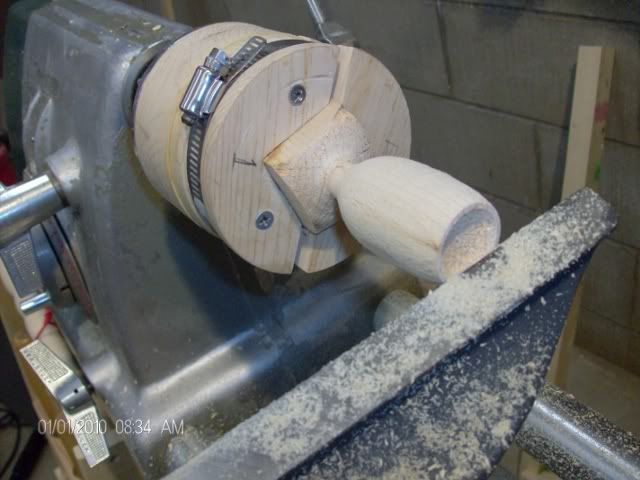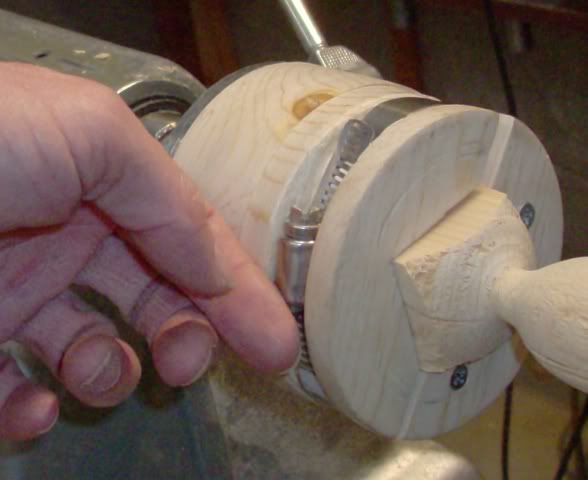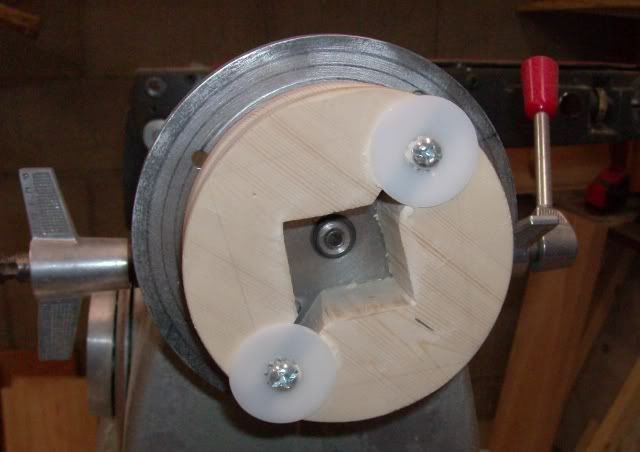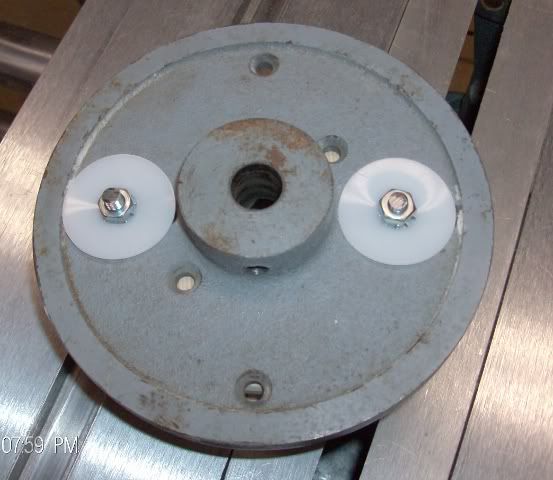Page 2 of 3
Posted: Fri Jan 01, 2010 4:21 pm
by wlhayesmfs
I have seen several on the tape method but I would rather look at recessing the clamp but not a bad idea for that use.
I am looking closer at it. How is the vibration from it?
Posted: Fri Jan 01, 2010 4:41 pm
by horologist
Jerry,
There is a similar chuck in Woodturning Wizardry by David Springett. But I think I like your idea with the modifications suggested by Leif even better still. In the book the portion with the square hole is one piece with a single cut through the edge and a screw to draw it tight.
For any unfamiliar with the book, he shows how to turn spheres within spheres within spheres... and other amazing objects. Even if you have no interest in making such elaborate dust collectors, the book is facinating and well worth a read.
Troy
Recessed Seems to Work
Posted: Fri Jan 01, 2010 5:13 pm
by bluekayak
Here is the original.

Here are a couple of images with the groove cut deeper.


This seems to work well. I had to give it the finger test just like on the safest saw video. Of course, it was going at very slow speed. It is important that the back of the screw and the trailing band is on the back side of the rotation. You definitely would not want to get hit with the nut and band.
To modify this version, I just used a chisel to cut the area near the clamp nut deeper. Next time, I would probably just make the groove much deeper when it is originally turned. I also might try this on the larger faceplate.
This does vibrate a little bit when you start out, but not too bad. Once it gets rounded out it is fine.
Thanks everyone for the tips and suggestions. It definitely is much better having that nut recessed.
Jerry Floren
St. Peter, MN
Posted: Fri Jan 01, 2010 8:19 pm
by tkhudson
wlhayesmfs wrote:I have seen several on the tape method but I would rather look at recessing the clamp but not a bad idea for that use.
I am looking closer at it. How is the vibration from it?
I am not sure what your reference to vibration is... I seriously doubt the tape would cause any more off balance than the screw drive of the hose clamp which probably weighs 100 times more than a piece of tape
Posted: Fri Jan 01, 2010 9:52 pm
by wlhayesmfs
sorry was not clear on my post, I was just talking about any vibration from your home made chuck. Not the added tape.
sorry. Looks Like a good extra to use to work with.
thanks
Posted: Mon Jan 18, 2010 7:45 pm
by kameljoe21
that does seem to work well for you
i just might make one some time and try it out
Posted: Mon Jan 18, 2010 9:51 pm
by bluekayak
I think it works pretty well. However, I am very inexperienced. I just started turning, and have not done very much.
I wanted a chuck for 1 1/2 inch stock. This works, but your work is not centered exactly. For what I was doing it did not matter. The lathe centered it, and it did not matter that I lost some stock from being off center.
It is really easy to make, especially if you have a band saw or a jig saw to make the cuts.
I also have a larger faceplate that came with my Greenie. It has slots, and that made it possible to make a somewhat adjustable chuck. However, I do not think that faceplate is a Shopsmith.
Jerry Floren
St. Peter, MN
Posted: Tue Jan 19, 2010 12:18 am
by robinson46176
Nice simple chuck and the recessed clamp is a good idea.
"BUT" protrusions on lathe chucks both metal lathes and wood lathes are a given and anyone planning any turning needs to learn (quickly) how to stay out of that zone.
http://www.mini-lathe.org.uk/images/4_jaw_independent_chuck.jpg
Just look at this spinning lathe dog.
http://www.micromark.com/html_pages/ins ... 82510a.gif
You MUST stay out of those zones. DO NOT depend on the machine or set-up to protect you.
-
I keep repeating the story of the guy on another list several years ago that said cutting his thumb open on his table saw was his fault because he did not install the guard. I kept insisting that it was his fault because he stuck his thumb into the spinning blade... His thumb should not have been in the blade zone whether he had the guard installed or not. Machinery of any kind is not a case of "guard in place", I can be careless and sloppy or "guard off" I must be careful. Danger zones are still there guard or no guard and guard or no guard you should not place anything you care to keep in that zone...
Posted: Tue Jan 19, 2010 1:08 am
by Ed in Tampa
robinson46176 wrote:Nice simple chuck and the recessed clamp is a good idea.
"BUT" protrusions on lathe chucks both metal lathes and wood lathes are a given and anyone planning any turning needs to learn (quickly) how to stay out of that zone.
http://www.mini-lathe.org.uk/images/4_jaw_independent_chuck.jpg
Just look at this spinning lathe dog.
http://www.micromark.com/html_pages/ins ... 82510a.gif
You MUST stay out of those zones. DO NOT depend on the machine or set-up to protect you.
-
I keep repeating the story of the guy on another list several years ago that said cutting his thumb open on his table saw was his fault because he did not install the guard. I kept insisting that it was his fault because he stuck his thumb into the spinning blade... His thumb should not have been in the blade zone whether he had the guard installed or not. Machinery of any kind is not a case of "guard in place", I can be careless and sloppy or "guard off" I must be careful. Danger zones are still there guard or no guard and guard or no guard you should not place anything you care to keep in that zone...
Farmer
How very right you are! Most Excellent!
Prototype #2
Posted: Tue Jan 19, 2010 9:25 pm
by bluekayak
I thought I'd put up some pictures of my revised version. This is on a 6 inch faceplate that came with my 1955 Greenie. However, I wonder if it actually is a Shopsmith faceplate? It is steel instead of aluminum and has a slotted screw instead of an Allen screw.
The wooden part was turned on the smaller faceplate shown in the earlier pictures, and I made sure to recess the hose clamp nut. This faceplate has slots where the bolts attach so that it is possible to get the material a little more centered than version 1. The lines are helpful for centering the material, and they were drawn on with a fine line marker while the faceplate turned. This is set up for 1 1/2 inch stock, but you could cut different size squares for larger or smaller stock.

Here it is from the back. The slots in the faceplate are underneath the nylon washers.

Jerry Floren
St. Peter, MN




